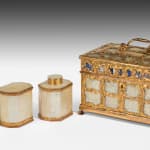George III ‘Aventurine’ and Mother of Pearl Ormolu Tea Caddy
ENGLAND, circa 1770
19 x 25 x 16 cm
Further images
-
(View a larger image of thumbnail 1
)

-
(View a larger image of thumbnail 2
)

-
(View a larger image of thumbnail 3
)

-
(View a larger image of thumbnail 4
)

-
(View a larger image of thumbnail 5
)

-
(View a larger image of thumbnail 6
)

-
(View a larger image of thumbnail 7
)

-
(View a larger image of thumbnail 8
)

-
(View a larger image of thumbnail 9
)

With a row of aventurine panels in the lid and mother of pearl panels within the main body of the casket, enclosed within an elaborate ormolu decorative trellis. The hinged lid opens to reveal an interior lined with blue velvet. The caddy contains a set of two tea caskets and a sugar cannister, each decorated with mother of pearl and ormolu. Curiously, in the centre of the cannister’s base, the ormolu has been decorated with a central square, which mimics the pattern used in the trellis.
Christopher Gilbert discusses the origin of the expression ‘tea chest’, noting that: ‘The term ‘tea chest’ was current in Chippendale’s day, but half a century later Thomas Sheraton remarked in his Cabinet Dictionary of 1803 that the word caddy ‘is now applied to various kinds of tea chests, of square, octagon and circular shapes.’ (Christopher Gilbert, ‘Chapter 11: Tea Chests and Tea Caddies’ in ‘Masterpieces of English Furniture: The Gerstenfeld Collection’, Christie’s Books, 1998, p.184). He illustrates a similar tea caddy from the Jon Gerstenfeld Collection, which he describes as a ‘conspicuously fine rococo specimen’ (ibid, p.184). The caddy is formed of blue glass ‘aventurine’ panels, overlaid by a similar scrolling trellis to our tea caddy, which is made of pinchbeck, a copper and zinc alloy similar to brass. This tea caddy also contains comparable mother-of-pearl cannisters (ibid, fig.111, p.248).
The Corning Museum of Glass has a Footed Casket in its collection which is catalogued as ‘possibly by James Cox’ (Accession Number: 84.2.54; Credit Line: Gift of Lucy Smith Battson). It is of very similar form and size to our tea caddy and the engraving on the base is similar to that on the base of this caddy.
A Miniature Secretary made by James Cox, incorporating a watch and dated c.1766–72, is housed in the collection of the Metropolitan Museum in New York. The case is made from agate with gold mounts, gilded brass, pearls, and paste jewels set in silver; the dial is made from white enamel. The Miniature Secretary plays tunes on a hidden music box, is supported on four bulls, and is adorned with bejewelled butterflies and flowers (Accession Number: 46.184a–c; http://metmuseum.org/exhibitions/view?exhibitionId={10EBB2581456-4021-893A-E0D9C69FC88A}&oid=199773).
The State Hermitage Museum has a Table Clock mounted on Rhinoceroses with a Necessaire and Musical Mech (Inventory Number: Э-2003) by James Cox, dated 1772, constructed from gold, silver, metal alloys, pearl and coloured glass and agate; https://www.hermitagemuse um.org/wps/portal/hermitage /digitalcollection/09.+Jewellery/102 000/?lng=en).
Whilst both these clocks are made from gold, a Musical Clock with ormolu mounts, inscribed ‘James Cox, London’ and catalogued, in 1957, as being in the possession of H. Blairman & Sons Ltd, 23 Grafton Street, London, W1, demonstrates James Cox’s use of ormolu.
James Cox (c.1723–1800) Goldsmith and Entrepreneur: James Cox, of 103 Shoe Lane, London, is most famous today for the elaborate musical clocks and automata that he produced and exported to China and other countries in the second half of the eighteenth century, some of which were exhibited in his celebrated museum of automata in Spring Gardens, Charing Cross from 1772 to 1775. Many of his products were very large – as demonstrated by the numerous clocks in the Palace Museum, Beijing; the ten-foot high life-size Peacock Clock, with its clockwork-driven automata, which was brought to Saint Petersburg in 1781 and is housed in the Hermitage Museum, St Petersburg; and the life-size swan automaton with silver plumage in the Bowes Museum, Barnard Castle.
However, Cox himself was not a clockmaker by trade but a goldsmith and a jeweller, producing many smaller articles in his own Shoe Lane workshop or through other craftsmen working to his designs. On his trade card bearing the London address ‘At the Sign of the Golden Urn’, James Cox proclaimed himself a goldsmith who: ‘Makes Great Variety of Curious Wares in Gold, Silver and other METALS. Also, Amber, Pearl, Tortoiseshell and Curious Stones’. An exhibition catalogue of his work at the Museum at Spring Gardens, Charing-Cross also makes a number of references to his use of ‘pearl’. The most characteristic of Cox’s smaller pieces were necessaires, snuffboxes and caskets made of agate panels held in gold or gilt-metal cagework. These luxury articles, which occasionally incorporated musical movements and watches, were sometimes used as elements in his larger compositions. As well as being exported, such pieces were sold in the domestic market. Whilst related articles were made by other London jewellers at this period, like the Barbot family, Cox was the main producer of articles in this style. A distinctive feature of Cox’s work was the way in which he often brought together complete components to create larger and more impressive objects. This modular approach to design and manufacture was not just employed in his larger pieces but can also be seen in smaller articles like necessaires and small musical clocks.









